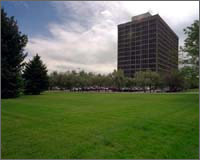Case Studies
The following case studies provide information about the performance, economics, and/or success of water efficiency projects. Federal managers can get a good understanding about what is possible at their sites or learn what other managers are doing. Another good source for information on federal water efficiency projects are web sites for the individual agencies listed in the resources section of this site and the FEMP Focus newsletters.
Every year FEMP honors innovative Federal energy managers at the Federal Energy and Water Management Awards. Learn what great water efficiency projects have been implemented by fellow Federal managers.
Veterans Hospital Walk-thru Audit
The FEMP SAVEnergy program performed a water audit of the Portland VA Medical Center in Oregon. The audit collected data on water use rates and times of use for toilets, urinals, faucets, single-pass water-cooled equipment, cooling towers, boilers, irrigation equipment, sterilizers, dishwashers, laundry equipment.
Biscayne National Park
FEMP provided technical assistance to Biscayne National Park to evaluate a reverse osmosis (RO) water system for a remote area of the park called Adams Key.
Sandia National Laboratories
In the Federal sector, individual buildings and water-using processes within a building or facility are often not metered separately. This does not mean that it is impossible to determine water use per building or even per process, however. For example, at DOE's Sandia National Laboratories in Albuquerque, New Mexico (SNL/NM), site staff are taking a systematic, comprehensive approach to water conservation and surveying their facility's water use. Not only does this help SNL/NM staff better understand water use at their facility, it also helps them determine which buildings and processes have the greatest potential for cost-effective water conservation projects.
Staff have conducted a site-wide water survey by using data on metered sewer flows; process knowledge of major water users (cooling towers, evaporative cooling units, ultra-pure water production, irrigation, and industrial facilities); standard water use for building occupants; existing water meter flows; and data from portable water meters. By adding calculated, nonmetered sewer flows to the metered sewer flows, staff were able to develop a water balance. Calculated sewer flows were within 10% of the metered flows, indicating the accuracy of the calculated flow numbers. To find out more about this "meterless audit" method, see the article titled "Sandia National Laboratory Conducts Water Survey to Identify Conservation Measures" in the July/August 1998 issue of FEMP Focus. To read about new projects at SNL/NM, visit their water conservation program web site.
Denver Federal Center

Indoor and outdoor water-efficient technologies were installed in and around Building 67 at the Denver Federal Center. (PIX 00660; Warren Gretz, NREL)
In this project, FEMP worked with DOE's National Renewable Energy Laboratory, the General Services Administration, the Bureau of Reclamation, the U.S. Environmental Protection Agency, several equipment manufacturers, and the Denver Water Department (the local utility) to meet the following objectives:
- Improve energy and water efficiency
- Deploy U.S.-manufactured water technologies
- Reduce life-cycle costs and improve reliability
- Establish a showcase site to demonstrate effective technologies and practices for water conservation.
The project partners have successfully retrofitted parts of a large office building in the Denver Federal Center with numerous water-conserving fixtures and installed a computer-controlled irrigation system on the grounds, among other measures.
The Pentagon
A few years ago, estimates indicated that the Federal Facilities Division of the Department of Defense's Washington Headquarters Services, Real Estate and Facilities Directorate at the Pentagon used 8 million gallons of water each year to irrigate the formal plantings that surrounded the parade field at the site. The total cost of that water in 1998 was $35,000, which indicated that cost savings could be significant if water conservation measures could be implemented there.
A study found that there were few faucets at the site, and those few were frequently inoperable. Watering the plantings with hoses was time-consuming and difficult to schedule. So there was a definite need to upgrade irrigation practices at the site. The solution was to irrigate about 7.2 acres of plantings with a state-of-the-art, automated, underground irrigation system using water from the nearby Potomac River. You can read more about this project in an article titled "Pentagon Plans a Water-Conserving Irrigation Project," which appeared in the July/August 1998 issue of the FEMP Focus newsletter.
















